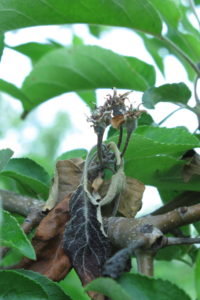Maryblyt 7.1 is now available for download at http://grapepathology.org/maryblyt
For new growers: Maryblyt is a fire blight prediction model. Fire blight is caused by the bacterium Erwinia amylovora. It is one of the most destructive diseases of apple, pear, and quince worldwide (Fig. 1). There are five distinct phases associated with fire blight, and include blossom, canker, shoot, root, and trauma blight phases. However, only the blossom blight phase offers growers the opportunity to break the disease cycle. Today, blossom blight can be managed more successfully using disease forecasters such as Maryblyt. Maryblyt predicts fire blight infection events by identifying periods when weather conditions and tree phenology are suitable for infection, allowing growers to time antibiotic applications when they can be most effective. The current version is due to the efforts of Drs. Nita at Yoder at Virginia Tech.
Maryblyt was originally developed by Dr. Paul W. Steiner, University of Maryland, and Gary Lightner, USDA, AFRS. Maryblyt 7.1 was developed by Dr. Alan R. Biggs, West Virginia University, and Dr. William Turechek, USDA, and adapted for Windows from the original source code. Maryblyt, the program, the name, and anything to do with it is copyrighted by the University of Maryland and all rights are reserved.
For more information on the Maryblyt model, see: https://www.plantmanagementnetwork.org/pub/php/volume16/number1/PHP-RS-14-0046.pdf
